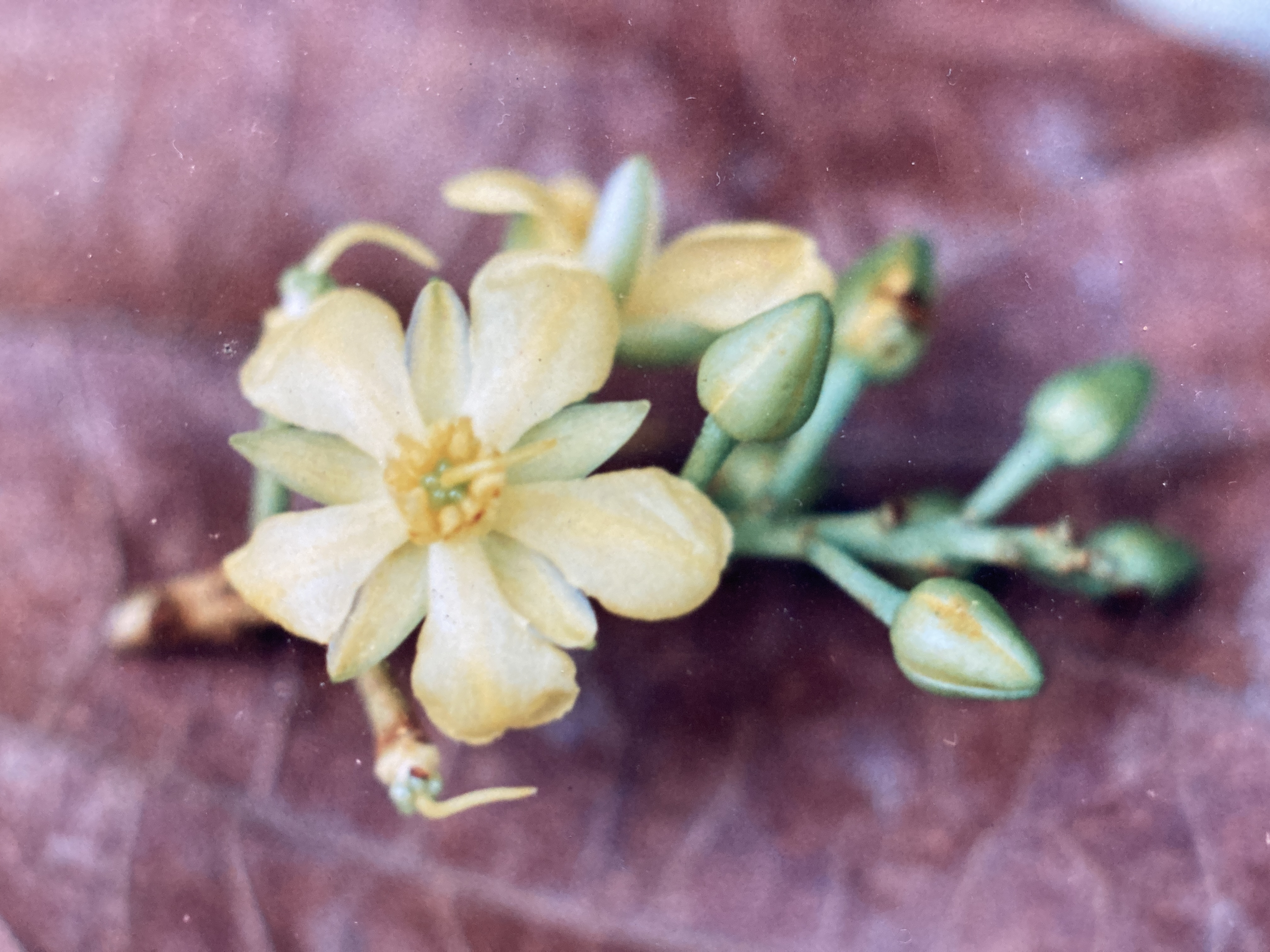Ouratea lucens (Kunth) Engler.
Rare evergreen treelet (1-3 m) and a very inconspicuous component of the shaded, primary forest shrub-layer. Only during fertile months (September to December), when its exotic and noteworthy flowers and fruits are in evidence, may attention be drawn to this unusual plant.
Description: Ouratea is a small tree and trunk diameters are limited to a few centimeters (3-4). Smooth, brown bark envelopes the single, cylindrical and straight stem. Growing vertically, the bole gives rise to a small number of horizontal branches that droop slightly under their own weight. The Ouratea crown is open and thin (a characteristic it shares with the many other species inhabiting this niche). Leaves are simple, alternate, and of widely varying dimensions (ranging from 11-20 cm by 3-6 cm). All are narrow and elliptical, tapering to points at both extremes. The distal ends of the serrate blades sport well-developed drip tips. Leaf venation is distinctive – with secondary veins branching perpendicularly off the mid-rib and curving abruptly toward the apex (see image). Small, 1 cm stipules are present beside the petioles of younger leaves. New foliage, made obvious by its light, flesh-tone color, appears during growth spurts that may occur at any time during the year – but with most frequency in September (at the start of the annual fertility cycle).
Only slightly fragrant, Ouratea flowers (2 cm) form in terminal racemes. Green, conical buds open into pale-yellow blossoms, each composed of a pedestal (1 cm), five narrow sepals, five tear-drop shaped petals, ten stamens, and a single pistil. Clustered at the center of the flower, the stamens stand erect and form a cylinder that surrounds and protects the pistil. Deep inside, making up the base of the pistil, are five minute green ovaries. The main thrust of Ouratea‘s flowering season is short and synchronized, lasting from mid-October to mid-November. Some trees may nevertheless continue producing a small number of racemes well into January. Individuals of this species generally are not fertile on an annual basis, though there is evidence to suggest that a once every two year flowering frequency is common.
The unusually-shaped fruits (3 cm) begin developing quickly as the flowers die. When mature, each sports from one to a maximum of five green, ovoid drupes (1 cm) arranged pentagonally at the distal-end of a curious, club-shaped, swelling. This swelling – having developed from the base of the old flower – is red, dimpled, and heavy enough to weigh down the end of the branch to which it is attached. Together with its spoke-like crown of green fruits, it resembles the hub of a rimless wheel. The green drupes each bear a single seed underneath a thin skin. Harvests last from December through February.
Similar Species: The flowers and fruits of this species are unique in Manuel Antonio National Park (MANP) and they allow positive identification of fertile samples. When sterile, the highly curved secondary veins (readily visible in Ouratea leaves when held against the light) distinguish this species from all other MANP trees, with the possible exception of Swartzia simplex. Of much larger stature (8-10 m), this latter species is unlikely to be confused with Ouratea.
Natural History: Ouratea flowers are probably pollinated by bees or other large insects. Fruits are made visible by the brightly colored, swollen flower bases that hold the five green seeds. These structures are probably eaten by forest mammals and birds. Seed dispersal would then occur as the relatively inedible green seeds are dropped by the forager – itself presumably consuming the food while on the wing (or hoof). Manuel Antonio’s Ouratea lucens population is limited to a small number of trees that are all characterized by extremely low stature. While walking in the forests of the northern Osa Peninsula – forests separated from those of Manuel Antonio by only 40 km – a single Ouratea specimen measuring some 5m in height was encountered. Three or four times as large as any Manuel Antonio Ouratea, this tree was superlative in every respect. Even its flowers and fruits were disproportionately large – some two or three times their “normal” size. Aside from being an order of magnitude too big, all anatomical characteristics of this individual were otherwise identical to those of the smaller version. Whether this plant represents a different, though closely related, species, or rather a larger phenotypical expression of the same genotype (whose expression was prompted by the congenial growing conditions of this part of Costa Rica), is yet to be determined.
Distribution: In MANP, Ouratea is observed along the Punta Catedral trail and in the Primary forests near the ANEP road. This tree is also found in the Osa Peninsula. Ouratea ranges from Mexico to Colombia.



